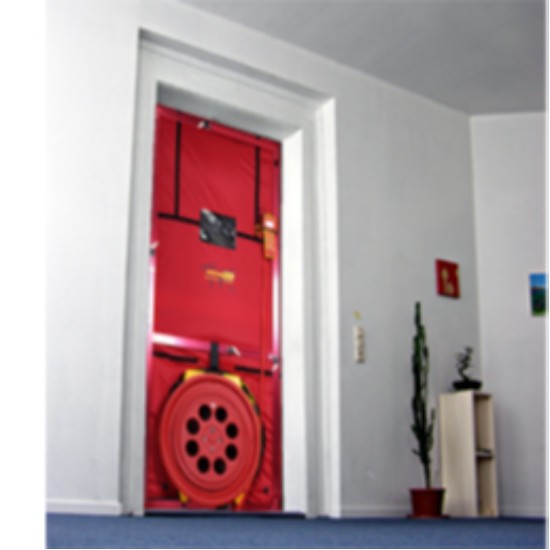
If you have a Clean Agent System, it is necessary to perform a Room Integrity Fan Test at installation and during your annual inspection.
What if you lost a single day’s worth of data? Even in a small business of 15 office employees, saving work on a network server can be expensive. What if you lost a week, or even a month of data?
In 2006 to 2010, there were an estimated 209 reported U.S. structure fires per year that started in electronic equipment rooms. Clean Agent Systems are the best choice for fire protection in an IT room.
Inspections: Room Integrity Fan Test
A Room Integrity Fan Test, or Door Test, measures how well-sealed a room is by sealing the room and using a fan to draw a vacuum and pressurize the space. The fan speed is adjusted to obtain a flow pressure equal to that exerted during a fire suppression system discharge. The fan is also reversed to depressurize the room, and readings are taken at both the pressurized and depressurized state. Readings obtained are entered into a computer program designed to calculate the equivalent leakage area (ELA) for the room. Because it is measuring oxygen, which is lighter than clean agent chemicals, the ELA calculated is always a worst case leakage calculation for the room. The retention time for the air in the room is what decides if the room is properly sealed for a gaseous suppression system, as the gas must be able to be held in the room for long enough to extinguish the fire and ensure that it does not reignite. A minimum retention time of ten minutes applies in most cases.
If a Room Integrity Fan Test is unable to be conducted, NFPA 2001 Annex C.1.2.2 (5) allows for the option to seek approval from the Authority Having Jurisdiction to waive the quantitative results of a standard door fan test and instead conduct a detailed leak inspection. In this inspection, the door fan is used to blow air into the room while an inspector uses a smoke pencil to closely examine all floor and walls to look for leaks.
A Room Integrity Fan Test should be performed annually. Throughout the year, the property owner/manager should be maintaining a log of any penetration created in the room walls, etc. whether from internal staff or contractors. This information will be reviewed by the Fire Safety Professional performing the Room Integrity Fan Test. A clean agent fire suppression system is dependent on maintaining a certain level of the gas in the server room for a particular length of time, if the leaks are not sealed properly and too much gas leaks out then the fire may reignite.
Learn more about constructing a server room so that it is properly sealed for a clean agent system.
What other Inspections are needed for a Clean Agent Suppression System?
Twice a year clean agent suppression systems need to be inspected to check the agent quantity and pressure of the refillable containers. Your Inspector will also check the agent tanks for any physical damage that would require the tanks to be replaced. Annually, a detailed inspection of the clean agent system is required. During this inspection, all systems must be thoroughly inspected and tested to ensure proper operation (it is not required for the agent to be discharged). This is when your Room Integrity Fan Test will be performed. In addition, the hoses will be checked for signs of damage, and the smoke detectors will be tested along with your alarm panels. Your clean agent system has its own alarm panel separate from your building’s alarm panel. If you clean agent system is activated, it should notify and set off the alarm system for your building as a whole. Because of this, both the clean agent alarm panel and the building alarm panel are tested.
A1 is a leading expert on the latest technology in life safety. To find out more information or to ask a question, click here or call us at 1-800-859-6198.
